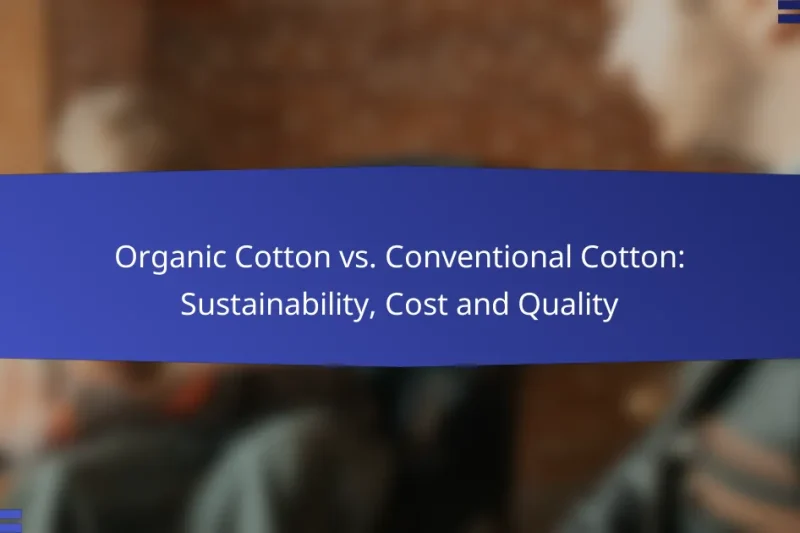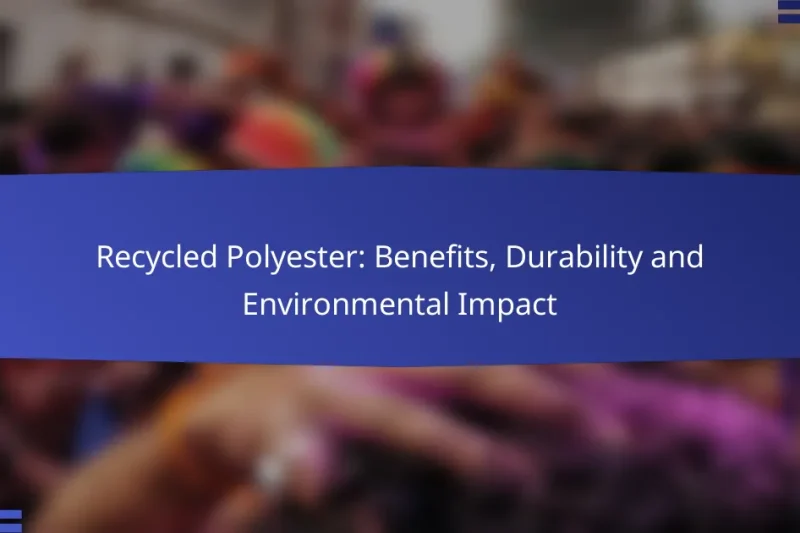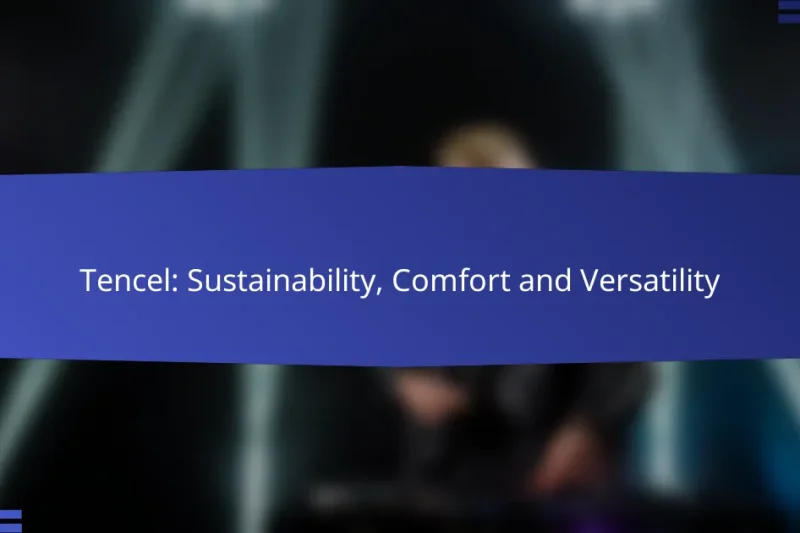Organic cotton stands out as a more sustainable alternative to conventional cotton, thanks to its environmentally … Organic Cotton vs. Conventional Cotton: Sustainability, Cost and QualityRead more
Sustainable Clothing Materials
Sustainable clothing materials, such as organic cotton, Tencel, hemp, recycled polyester, and bamboo fabric, are designed to minimize environmental impact through eco-friendly production processes. By choosing these materials, consumers can significantly reduce resource consumption and pollution, contributing to the preservation of natural ecosystems and the fight against climate change. Various sources, including online retailers and local eco-friendly shops, offer these materials, making it easier to align your wardrobe with sustainable values.
Eco-Friendly Material Certifications: Types, Importance and Standards
Eco-friendly material certifications are essential standards that validate the sustainability and environmental impact of products. They … Eco-Friendly Material Certifications: Types, Importance and StandardsRead more
Recycled Polyester: Benefits, Durability and Environmental Impact
Recycled polyester is a sustainable alternative that significantly reduces environmental impact while offering impressive durability and … Recycled Polyester: Benefits, Durability and Environmental ImpactRead more
Bamboo Fabrics: Environmental Impact, Benefits and Uses
Bamboo fabrics are emerging as a sustainable textile option, offering numerous environmental benefits such as biodegradability … Bamboo Fabrics: Environmental Impact, Benefits and UsesRead more
Hemp Clothing: Benefits, Trends and Eco-Friendliness
Hemp clothing is gaining popularity due to its numerous benefits, including sustainability, durability, and comfort. As … Hemp Clothing: Benefits, Trends and Eco-FriendlinessRead more
Tencel: Sustainability, Comfort and Versatility
Tencel is a sustainable fabric made from responsibly sourced wood pulp, designed to minimize environmental impact … Tencel: Sustainability, Comfort and VersatilityRead more
Linen vs. Cotton: Sustainability, Durability and Care
When comparing linen and cotton, sustainability, durability, and care are key factors to consider. Linen is … Linen vs. Cotton: Sustainability, Durability and CareRead more
What are the best sustainable clothing materials?
The best sustainable clothing materials include organic cotton, Tencel, hemp, recycled polyester, and bamboo fabric. These materials are chosen for their lower environmental impact and sustainable production processes.
Organic cotton
Organic cotton is grown without synthetic pesticides or fertilizers, making it a more environmentally friendly option compared to conventional cotton. It typically uses less water and promotes healthier soil.
When purchasing organic cotton clothing, look for certifications such as GOTS (Global Organic Textile Standard) to ensure the material meets organic standards. This can help you make informed choices about the sustainability of your garments.
Tencel (Lyocell)
Tencel, or Lyocell, is made from sustainably sourced wood pulp, primarily from eucalyptus trees. The production process is closed-loop, meaning that solvents used in manufacturing are recycled, minimizing waste.
This fabric is known for its softness and breathability, making it an excellent choice for comfortable clothing. Additionally, Tencel is biodegradable, adding to its sustainability credentials.
Hemp
Hemp is a highly sustainable material that requires minimal water and no pesticides to grow. Its cultivation improves soil health and can be harvested multiple times a year, making it a renewable resource.
Hemp fabric is durable and becomes softer with each wash, making it suitable for various clothing types. However, it may be less widely available than other materials, so check specialty retailers for options.
Recycled polyester
Recycled polyester is made from post-consumer plastic bottles and other plastic waste, reducing the need for new petroleum-based materials. This process helps divert plastic from landfills and lowers carbon emissions associated with production.
When selecting recycled polyester clothing, look for brands that disclose the percentage of recycled content. This can help you gauge the environmental impact of your purchase.
Bamboo fabric
Bamboo fabric is derived from the fast-growing bamboo plant, which requires little water and no pesticides. The production process can vary, so it’s essential to choose brands that use eco-friendly methods.
Bamboo fabric is soft, breathable, and has natural antibacterial properties, making it suitable for activewear and undergarments. However, be cautious of the chemical processes used in some bamboo fabric production, and seek out sustainably produced options.
How do sustainable clothing materials benefit the environment?
Sustainable clothing materials significantly benefit the environment by reducing resource consumption and minimizing pollution. They promote eco-friendly practices that help preserve natural ecosystems and combat climate change.
Reduced water usage
Sustainable clothing materials often require less water during production compared to conventional fabrics. For instance, organic cotton uses about 90% less water than traditional cotton farming methods, which can consume thousands of liters per kilogram of fabric.
Choosing materials like hemp or Tencel can further decrease water usage, as these crops thrive in drier conditions. When selecting clothing, look for certifications that indicate lower water consumption in the production process.
Lower carbon footprint
<pMaterials like organic cotton, linen, and recycled polyester contribute to a lower carbon footprint by utilizing sustainable farming practices and reducing reliance on fossil fuels. For example, producing recycled polyester can cut carbon emissions by up to 70% compared to virgin polyester.
When shopping for clothing, consider brands that disclose their carbon footprint or are committed to carbon-neutral practices. This transparency can guide you toward more environmentally responsible choices.
Biodegradability
Sustainable clothing materials are often biodegradable, meaning they can break down naturally without harming the environment. Fabrics such as organic cotton, linen, and wool decompose within a few months to a few years, unlike synthetic materials that can take decades.
When selecting clothing, prioritize items made from natural fibers or those labeled as biodegradable. This choice not only reduces landfill waste but also supports a circular economy where materials can be reused and recycled effectively.
Where can I buy sustainable clothing materials?
You can buy sustainable clothing materials from various sources, including online retailers, local eco-friendly shops, and brand-specific stores. Each option offers unique benefits, making it easier to find materials that align with your values and needs.
Online retailers
Online retailers provide a wide selection of sustainable clothing materials, often with detailed descriptions of their eco-friendly practices. Popular platforms like Etsy, Amazon, and specialized websites like Eco Warrior or The Good Trade offer various options, from organic cotton to recycled fabrics.
When shopping online, look for certifications such as GOTS (Global Organic Textile Standard) or OEKO-TEX, which indicate that the materials meet specific sustainability criteria. Compare prices and read customer reviews to ensure quality and ethical sourcing.
Local eco-friendly shops
Local eco-friendly shops are excellent places to find sustainable clothing materials while supporting your community. These shops often carry unique, locally sourced fabrics and can provide personalized advice on sustainable practices.
Visit fabric stores or boutiques that specialize in eco-friendly products. You might find organic cotton, hemp, or bamboo fabrics, often at competitive prices compared to conventional materials. Engaging with local shop owners can also help you learn more about sustainable practices and new arrivals.
Brand-specific stores
Brand-specific stores often focus on sustainability and ethical production, making them a reliable source for sustainable clothing materials. Brands like Patagonia, Reformation, and Eileen Fisher are known for their commitment to eco-friendly practices and offer a range of materials.
When shopping at these stores, check their sustainability policies and material sourcing information. Many brands provide transparency about their supply chains, allowing you to make informed choices. Look for sales or clearance items to find sustainable materials at reduced prices.
What are the criteria for choosing sustainable clothing materials?
Choosing sustainable clothing materials involves evaluating their environmental impact, social responsibility, and overall lifecycle. Key criteria include certifications, sourcing practices, and production processes that prioritize eco-friendliness and ethical standards.
Certifications to look for
Certifications can help identify sustainable clothing materials. Look for labels such as Global Organic Textile Standard (GOTS), OEKO-TEX, and Fair Trade, which indicate adherence to specific environmental and social criteria. These certifications ensure that materials are produced without harmful chemicals and that workers are treated fairly.
Additionally, certifications like the Responsible Wool Standard (RWS) and the Forest Stewardship Council (FSC) can guide consumers toward materials sourced from responsible practices. Always check for the certification logo on clothing tags to verify authenticity.
Material sourcing practices
Sustainable clothing materials should be sourced from renewable or recycled resources. For instance, organic cotton and Tencel are often preferred due to their lower environmental impact compared to conventional cotton or synthetic fibers. When evaluating materials, consider their origin and the ecological footprint of their production.
Transparency in sourcing is crucial. Brands that disclose their supply chain practices and provide information about their material origins are more likely to adhere to sustainable standards. Look for companies that prioritize local sourcing to reduce transportation emissions.
Production processes
The production processes of clothing materials significantly affect their sustainability. Techniques that minimize water usage, energy consumption, and chemical inputs are essential. For example, waterless dyeing technologies and closed-loop production systems can greatly reduce environmental harm.
It’s also important to consider labor practices during production. Ethical manufacturing ensures fair wages and safe working conditions. Brands that invest in sustainable production methods often share their practices, making it easier for consumers to make informed choices.
How do sustainable clothing materials compare in terms of cost?
Sustainable clothing materials often come at a higher price point compared to conventional fabrics. Factors such as production methods, sourcing, and certifications contribute to these costs, making it essential for consumers to weigh the benefits against the price.
Price range of organic cotton
The price of organic cotton typically ranges from moderate to high, depending on factors like quality and sourcing. On average, organic cotton can cost about 20-50% more than conventional cotton due to the more labor-intensive farming practices and certification processes involved.
When purchasing organic cotton clothing, expect to pay anywhere from $15 to $50 for basic items like t-shirts or dresses. Higher-end brands may charge significantly more, reflecting their commitment to sustainable practices and ethical labor.
To make informed choices, consider looking for certifications such as GOTS (Global Organic Textile Standard) or OEKO-TEX, which can assure you of the product’s sustainability and ethical production. Always compare prices across different retailers to find the best value for organic cotton products.






